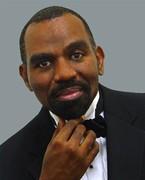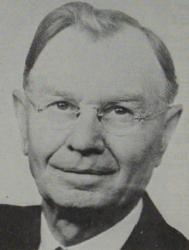Planning worship?
Check out our sister site, ZeteoSearch.org,
for 20+ additional resources related to your search.
- |
User Links
Person Results
Edmund S. Lorenz

1854 - 1942 Scripture: Hebrews 4:11-16 Author of "Dilo a Cristo" in Celebremos Su Gloria Pseudonymns: John D. Cresswell, L. S. Edwards, E. D. Mund,
====================
Lorenz, Edmund Simon. (North Lawrence, Stark County, Ohio, July 13, 1854--July 10, 1942, Dayton, Ohio). Son of Edward Lorenz, a German-born shoemaker who turned preacher, served German immigrants in northwestern Ohio, and was editor of the church paper, Froehliche Botschafter, 1894-1900.
Edmund graduated from Toledo High School in 1870, taught German, and was made a school principal at a salary of $20 per week. At age 19, he moved to Dayton to become the music editor for the United Brethren Publishing House. He graduated from Otterbein College (B.A.) in 1880, studied at Union Biblical Seminary, 1878-1881, then went to Yale Divinity School where he graduated (B.D.) in 1883. He then spent a year studying theology in Leipzig, Germany.
He was ordained by the Miami [Ohio] Conference of the United Brethren in Christ in 1877. The following year, he married Florence Kumler, with whom he had five children. Upon his return to the United States, he served as pastor of the High Street United Brethren Church in Dayton, 1884-1886, and then as president of Lebanon Valley College, 1887-1889.
Ill health led him to resign his presidency. In 1890 he founded the Lorenz Publishing Company of Dayton, to which he devoted the remainder of his life. For their catalog, he wrote hymns, and composed many gospel songs, anthems, and cantatas, occasionally using pseudonyms such as E.D. Mund, Anna Chichester, and G.M. Dodge. He edited three of the Lorenz choir magazines, The Choir Leader, The Choir Herald, and Kirchenchor. Prominent among the many song-books and hymnals which he compiled and edited were those for his church: Hymns for the Sanctuary and Social Worship (1874), Pilgerlieder (1878), Songs of Grace (1879), The Otterbein Hymnal (1890), and The Church Hymnal (1934).
For pastors and church musicians, he wrote several books stressing hymnody: Practical Church Music (1909), Church Music (1923), Music in Work and Worship (1925), and The Singing Church (1938). In 1936, Otterbein College awarded him the honorary D.Mus. degree and Lebanon Valley College the honorary LL.D. degree.
--Information from granddaughter Ellen Jane Lorenz Porter, DNAH Archives
Edmund S. Lorenz
Carl Haywood

b. 1949 Person Name: Carl Haywood (b. 1949) Scripture: Hebrews 4:15 Composer of "HAYWOOD'S HOME" in Wonder, Love, and Praise
Carl Haywood
Ira David Sankey

1840 - 1908 Person Name: Ira D. Sankey Scripture: Hebrews 4:15 Composer of "[O troubled heart, there is a balm]" in Sacred Songs No. 2 Sankey, Ira David, was born in Edinburgh, Pennsylvania, in 1840, of Methodist parents. About 1856 he removed with his parents to New Castle, Pennsylvania, where he became a member of the Methodist Episcopal Church. Four years afterwards he became the Superintendent of a large Sunday School in which he commenced his career of singing sacred songs and solos. Mr. Moody met with him and heard him sing at the International Convention of the Young Men's Christian Association, at Indianapolis, and through Mr. Moody's persuasion he joined him in his work at Chicago. After some two or three years' work in Chicago, they sailed for England on June 7, 1872, and held their first meeting at York a short time afterwards, only eight persons being present. Their subsequent work in Great Britain and America is well known.
Mr. Sankey's special duty was the singing of sacred songs and solos at religious gatherings, a practice which was in use in America for some time before he adopted it. His volume of Sacred Songs and Solos is a compilation from various sources, mainly American and mostly in use before. Although known as Sankey and Moody’s Songs, only one song, "Home at last, thy labour done" is by Mr. Sankey, and not one is by Mr. Moody. Mr. Sankey supplied several of the melodies. The English edition of the Sacred Songs & Solos has had an enormous sale; and the work as a whole is very popular for Home Mission services. The Songs have been translated into several languages.
--John Julian, Dictionary of Hymnology (1907)
Pseudonymns:
Harry S. Lower
Rian A. Dykes
====================
Sankey, I. D., p. 994, i. During the past fifteen years Mr. Sankey's Sacred Songs and Solos have had a very large sale, which has justified him in increasing the number of songs and hymns, including " New Hymns and Solos," to 1200. In 1906 he published My Life and Sacred Songs (London : Morgan & Scott). In addition to the "Story of his Own Life," the work contains an account of the most popular of his solos, with interesting reminiscences of the spiritual awakening of many who were influenced through his singing of them in public. In this respect it corresponds in some measure with G. J. Stevenson's Methodist Hymn Book, &c, 1883 (p. 1094, i.). It is an addition to the Sacred Songs and Solos, which will be held in esteem by many. In addition to his hymn, noted on p. 994, ii., Mr. Sankey gives details of the following:—
1. Out of the shadow-land into the sunshine. [Heaven Anticipated.] Mr. Sankey's account of this hymn is:—
"I wrote this hymn specially for the memorial service held for Mr. Moody in Carnegie Hall, where 1 also sang it as a solo. It is the last sacred song of which I wrote both the words and music. The idea was suggested by Mr. Moody's last words, 'Earth recedes; heaven opens before me . . . God is calling me, and I must go.' On account of its peculiar association with my fellow-labourer in the Gospel for so many years, the words are here given in full."
The hymn follows on p. 185, in 3 stanzas of 4 lines and a chorus.
2. Rejoice! Rejoice! our King is coming, [Advent.] Mr. Sankey writes concerning this hymn:—
"During one of my trips to Great Britain on the SS. City of Rome a storm raged on the sea. The wind was howling through the rigging, and waves like mountains of foam were breaking over the bow of the vessel. A great fear had fallen upon the passengers. When the storm was at its worst, we all thought we might soon go to the bottom of the sea. The conviction came to me that the Lord would be with us iu the trying hour, and sitting down in the reading room, I composed this hymn. Before reaching England the tune had formed itself in my mind, and on arriving in London I wrote it out, and had it published in Sacred Songs and Solos, where it is No. 524 in the edition. of 1888.
From Mr. Sankey's autobiographical sketch we gather that he was born at Edinburgh, in Western Pennsylvania, Aug. 28, 1840, joined Mr. Moody in 1871, and visited England for the first time in 1873. The original of the Sacred Songs, &c, of 23 pieces only, was offered as a gift to the London publishers of P. Phillips's Hallowed Song, and declined by them. It was subsequently accepted by Mr. K. O. Morgan, of Morgan & Scott, and is now a volume of 1200 hymns.
From a return kindly sent us by Messrs. Morgan & Scott, we find that the various issues of the Sacred Songs and Solos were:—
In 1873, 24 pp.; 1874, 72 pp. ; 1876, 153 hymns; 1877, 271 hymns; 1881, 441 hymns; 1888, 750 hymns; 1903, 1200 hymns.
In addition, The Christian Choir, which is generally associated with the Sacred Songs and Solos, was issued in 1884 with 75 hymns, and in 1896 with 281. The New Hymns & Solos, by the same firm, were published in 1888.
--John Julian, Dictionary of Hymnology, New Supplement (1907)
Ira David Sankey
L. W. Terley
Scripture: Hebrews 4:12 Author of "The Word of God Is Alive" in Baptist Hymnal 1991
L. W. Terley
Thomas S. Cobb

1876 - 1942 Person Name: T. S. C. Scripture: Hebrews 4:12 Author of "Go, Work!" in The New Wonderful Songs for Work and Worship Thomas S. Cobb (1876-1942), a native Texan, was educated in much the same circles as [Austin] Taylor, and received his music diploma from the Western Normal and College of Music in Dallas. He taught singing schools across Texas and the bordering states, and was particularly noted for the "Cobb Quartet" made up of his four daughters. He was recruited to Firm Foundation by Showalter in 1935.(Finley, 122ff.) Cobb edited only four hymnals for Firm Foundation before his death in 1942, but among these was the significant New Wonderful Songs (1933); at 296 hymns it was part of the trend toward more substantial publications.
Prior to his work with Firm Foundation, Cobb edited hymnals for the Quartet Music Company of Fort Worth, Texas. A search of WorldCat.org shows that he was involved with at least 7 books for this publisher, going back as far as the 1890s when it was called the "Quartette Company." One of these earlier works From the Cross to the Crown (1921?) was subtitled, "Scriptural Songs," and was co-edited with Elder T. B. Clark and T. B. Mosley, one of the most well-known singing school teachers among the Churches of Christ in the southeastern U.S. Mosley was also known as a staunch doctrinal conservative. This gives some idea of the bona fides Cobb brought with him during the era of the "hymnal controversy" surrounding E. L. Jorgenson's Great Songs of the Church. Jorgenson was firmly in the premillennial camp, and was an editor of Word and Work, the primary voice of this viewpoint within the Churches of Christ. Opponents of premillennialism objected to several hymns in Great Songs that supported this doctrine, or were at least questionable. (Most of these were removed or altered in the better-known "No. 2" edition).
Thomas S. Cobb passed from this life in 1942, shortly after the last of the pre-war Firm Foundation hymnals appeared.
--drhamrick.blogspot.com/2012/01/hymnals-published-by-firm-foundation.html
Thomas S. Cobb
Stephen P. Starke
b. 1955 Person Name: Stephen P. Starke, b. 1955 Scripture: Hebrews 4:14-16 Author of "Christ Sits at God's Right Hand" in Lutheran Service Book Rev. Stephen P. Starke has always had a heart for hymns. At a young age, Starke played hymns out of The Lutheran Hymnal and read through the hymnal to pass the time before Sunday services.
Pastor Starke graduated from Concordia University Chicago with a BA. While completing his MDiv from Concordia Theological Seminary, Fort Wayne, Indiana, he attempted his first hymn text and was encouraged to write more. Since that time, he has written more than 175 hymns inspired by music and the Scriptures. He has been commissioned to write hymns for special occasions, including the 125th anniversary of Concordia University Wisconsin, as well as his daughter’s wedding.
Because of his extensive work as a hymnwriter, Pastor Starke received an honorary doctor of letters degree from Concordia University, Irvine, California, and an honorary doctor of divinity degree from Concordia University Wisconsin in Mequon.
It is through the medium of hymns that Pastor Starke desires to preserve and pass on the truths of the Gospel for generations to come.
Stephen P. Starke
Emma Lou Thayne
Person Name: Emma Lou Thayne, b. 1924 Scripture: Hebrews 4:14-16 Author of "Where Can I Turn for Peace?" in Hymns of the Church of Jesus Christ of Latter-day Saints
Emma Lou Thayne


 My Starred Hymns
My Starred Hymns


